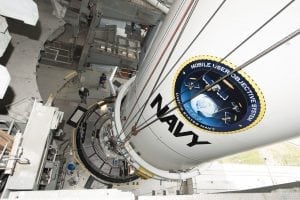Latest News

The U.S. Navy’s fourth Mobile User Objective System (MUOS) satellite, encapsulated in a 5-meter payload fairing, is mated to an Atlas 5 booster inside the Vertical Integration Facility at Cape Canaveral’s Space Launch Complex-41. Photo: ULA
[Via Satellite 09-01-2015] The United States military is eager expand implementation of its Mobile User Objective System (MUOS) once the fourth satellite is launched. The mission, recently delayed from Aug. 31 to Sept. 2 due to uncertainty in the weather conditions associated with Tropical Storm Erika, will turn the already active MUOS network into a global communications system.
MUOS is the U.S. military’s next generation narrowband satellite communications system that supports both legacy Ultra-High-Frequency (UHF) systems and new Wideband Code Division Multiple Access (WCDMA) systems. The fourth satellite is slated to launch on a United Launch Alliance (ULA) Atlas 5 rocket from Cape Canaveral Air Force Station. Over time, the U.S. Navy-run MUOS system will replace the legacy satcom system in use. The first three satellites launched in 2012, 2013 and 2015. Following the fourth launch, an on-orbit spare (MUOS 5) is slated to launch in 2016.
MUOS 4, once online, completes the operational constellation’s global capability. In an Aug. 28 call with reporters, senior military leaders and industry partners said MUOS is already in use today and, once complete, will play an even larger role in warfighter communications.
“Narrowband, is critical for warfighting missions, explained Capt. Joe Kan, MUOS program manager at the U.S. Navy. “Although it only represents 2 percent of the entire bandwidth that the DOD uses, it accounts for more than 50 percent of the DOD’s satellite communications capability. Narrowband communications are used by every combatant commander, every ship, submarine, aircraft, and on ground capabilities, as well as troops in the field. There’s a host of many applications that it’s used for, including special operations forces.”
Today, the legacy payload on MUOS is active and in use. Kan said the Navy is on track to begin operational tests with the WCDMA payloads in October of this year. Compared to legacy capabilities, Kan said WCDMA enables improved performance in urban and jungle environments, north and south latitudes, and the ability to seamlessly connect Beyond-Line-of-Sight (BLOS) globally in a smartphone-like capability on an IP protocol basis.
Military end users continue to demonstrate MUOS, according to Iris Bombelyn, Lockheed Martin VP of narrowband communications. She explains that one such test ran up not against the limitations of the satellite system, but of the aircraft in use.
“We’ve done testing that has reached as high as 89.5 degrees north latitude — only 30 miles from the North Pole — and the only reason we didn’t do it from the North Pole is because it takes a little bit to turn that C130. It couldn’t turn that any tighter,” she said.
Lockheed Martin, the prime contractor and system integrator for MUOS
Air Force Research Lab (AFRL), has also established communications using MUOS during an Antarctic resupply mission, Bombelyn added. Col. James Ross, program manager for tactical radios at the U.S. Army, said the Coast Guard has tested MUOS in the Arctic Circle as well. Other development testing for manpack radios using the MUOS waveform is underway now, preceding operational testing.
“The next big milestone for us is the Multi-Service Operational Test and Evaluation (MOT&E) that will be conducted this fall. Those results will help us determine the operational viability of the system, which we fully expect,” he said.
After MOT&E, the Army can look to field the radios, he said. The Army has already procured MUOS high-powered amplifiers needed to connect radios with the satellite. Several companies are developing radios that can use MUOS, and more than 55,000 are estimated to be compatible with a software upgrade.
All four ground stations for MUOS are complete, though the one located in Italy has run into a legal snafu. The U.S. embassy in Italy has sought to dispel misinformation about the safety of the Niscemi, Italy ground station. Kan said the U.S. is seeking to rectify the situation, but is able to fully operate MUOS with the three remaining ground stations located in Hawaii, Virginia, and Australia.
“We are working very, very closely with the American embassy in Italy and the U.S. Department of Defense (DOD) to prepare our leadership for any eventuality that may occur with the court decision that’s upcoming,” he said.
In preparation for the launch of MUOS 4, Walt Lauderdale, MUOS 4 mission director at the Air Force Space and Missile Systems Center (SMC), said the government team has completed hundreds of hardware reviews and verification tests for both the satellite and the launch vehicle. Jim Sponnick, VP of Atlas and Delta programs at ULA, said the company completed the vertical integration of six structural elements for the launch as well as the Centaur upper stage offsite. ULA and the Air Force found that offsite vertical integration removes operations from the critical path to launch at the site, allowing for reduced time between launches. It also mitigates the risk of weather-related processing delays, and provides for a safer environment for employees, he said.
Kan said discussions regarding the successor to MUOS are currently ongoing, though no final decision has been made. Pre-acquisition activities could start in 2017 and one option being considered is a MUOS 6, he added. Kan said no funding has been allocated for such a satellite, but that discussions on the future of MUOS are ongoing within the U.S. and with allies Australia, the Netherlands, Canada, and the United Kingdom.
Get the latest Via Satellite news!
Subscribe Now